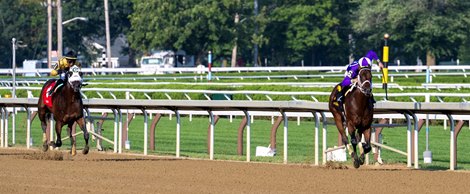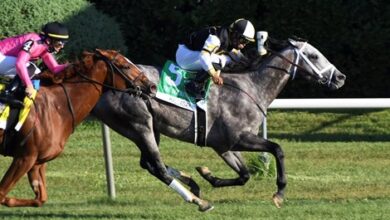A Breakdown That Calls for Further Review

In the five months before New York Thunder suffered a catastrophic breakdown in the H. Allen Jerkens Memorial Stakes (G1) Aug. 26 at Saratoga Race Course, he had been scratched from four different stakes races, placed on the veterinarians’ list once for unsoundness, and once more for injury.
He received three intra-articular injections in the two months before his fatal injury suffered in the stretch run of a race that he posted exceptional fractions and seemed a certain winner. He was saddled that day by trainer Jorge Delgado, who carried a less-than-sterling record in terms of equine safety and regulatory sanctions.
New York Thunder would be the eighth fatality during racing at this year’s Saratoga meet and while each is receiving scrutiny, this final loss in particular points to a need for close examination of industry rules, standards, and practices.
Those factors include examining:
- How scratches are reported, specifically in Kentucky, and veterinarians’ list standards.
- Trainers’ records relative to equine deaths per start.
- Medication policies that allow multiple injections to a horse in a relatively short period of time—a practice the Horseracing Integrity and Safety Authority plans to soon address.
Problematic Five Months
In the five months before New York Thunder suffered that catastrophic breakdown, he compiled a concerning record in terms of soundness. But were those issues fully communicated in records? Because of inconsistencies in Kentucky’s approach to scratches by regulatory vets and trainers relative to other major racing states, the problems may not have been fully expressed.
In those five months, New York Thunder was scratched from four stakes races and twice placed on the veterinarians’ list, once for lameness in Kentucky and once for “injury, no work” in New York. Three times he was scratched from stakes races in Kentucky and each of those scratches was attributed to a request from the “trainer.” After the first of those scratches, Kentucky records show he was placed on the vets’ list, which offers immediate protection for the horse. But he was not placed on the vets’ list after the final two scratches in Kentucky.
After winning both his starts last year, New York Thunder had a difficult time making his 3-year-old debut in 2023. On March 25 New York Thunder was scratched from the Animal Kingdom Stakes at Turfway Park. The race chart lists “trainer” as the source of the scratch recommendation. He was placed on the veterinarians’ list for lameness, which under HISA vet list rules is categorized as unfit or unsound. (The rule’s wording will soon be updated to “unsoundness.”)
A week later New York Thunder breezed a half-mile in :46 4/5 seconds at Keeneland. He came off the vets’ list April 8 and breezed again April 10 at Keeneland, going four furlongs in :48 1/5. The connections then entered New York Thunder in the April 16 Palisades Stakes for sprinters on the Keeneland turf. Again New York Thunder was scratched from the race and again the decision was attributed to the trainer. But unlike the first time, there would be no trip to the vets’ list.
New York Thunder was entered again just two weeks later north of the border. He would win the six-furlong Woodstock Stakes April 30 on the all-weather surface at Woodbine by 7 1/2 lengths.
Off that win, New York Thunder was entered in the Woody Stephens Stakes (G1) on the dirt at Belmont Park on Belmont Stakes Day, June 10. Again he would be scratched, but this time—in New York—the reason for the scratch would be listed as “veterinarian.” This would result in New York Thunder being placed on the vets’ list for seven days under the reason, “injury, no work” due to what was diagnosed as a bruised foot.
The assigned days are in line with HISA rules that call for a horse placed on the vets’ list with “injury,” to receive a seven-day stay. The “injury” designation falls into a different category than “unfit/unsound.” The standards for increased time on the vets’ list for multiple trips within a year all fall in the “unfit/unsound” category. HISA rules call for a horse that makes a second trip to the vets’ list for “unfit/unsound” in 365 days’ time to receive 45 days on the vets’ list.
As it played out, New York Thunder came off the New York vets’ list seven days later. On June 23 he worked a half-mile in :48 at Monmouth Park but before he would race again, he’d be scratched again.
New York Thunder would be entered in the Maxfield Overnight Stakes July 2 at Ellis Park, a race just more than three weeks after the scratch from the Woody Stephens and 10 days after his Monmouth work—the horse’s lone breeze or race since May 27. Again New York Thunder would be scratched, and again—matching his previous two scratches from stakes in Kentucky—the decision would be attributed to “trainer.”
Like the time at Keeneland that the trainer initiated the scratch, no trip to the vets’ list would follow.
It should be noted that Delgado did not respond to BloodHorse requests by phone and text for comment that could have clarified reasons for these scratches. It also should be noted that these scratches would not be cases of also-eligible horses or a horse being scratched because of a surface change—these types of circumstances and others are listed as such on the scratch explanations.
Getting back to the timeline, the July 2 race had originally been scheduled for Churchill Downs until that meet was moved to Ellis Park in early June after a string of equine deaths marred the spring meet at the Louisville track. While New York Thunder would be scratched from a scheduled Kentucky start for a third straight time, he would resurface in New York—at another meet that eventually would fall under scrutiny after a high number of catastrophic breakdowns.
Twenty-six days after being scratched at Ellis, New York Thunder would be entered in the Amsterdam Stakes (G2) July 28 at Saratoga. This time he would race. And he would race spectacularly well. In his first dirt race, New York Thunder led at every point of call, covering the first half-mile in a blistering :43.56. He drew off in the stretch to score by 7 1/2 lengths. The son of Nyquist completed the 6 1/2 furlongs eased up (because he was racing in-hand) in 1:14.65 after running six furlongs in 1:07.77, faster than the track record for three-quarters of a mile.

New York Thunder blazes in the Amsterdam at Saratoga Photo by Skip Dickstein
Off that effort, the connections opted to again try top-level competition—the H. Allen Jerkens Memorial Stakes. In the five months before the Aug. 26 test at Saratoga, New York Thunder had been scratched four times from stakes races, one specifically by a regulatory vet in New York and three times in Kentucky. He’d been placed on the vet’s list twice. On the other hand, during that time he’d mixed in a pair of stakes wins by a combined 15 lengths.
By the time Aug. 26 rolled around, the Saratoga meet had seen seven equine deaths during racing, including the breakdown of Maple Leaf Mel in the stretch of the Test Stakes (G1) three Saturdays earlier in a race broadcast on national television. On the muddy, sealed track, New York Thunder would duel with Woody Stephens winner Arabian Lion through a half-mile in :44.40 in the seven-furlong dirt race for 3-year-olds. New York Thunder put his early rival away and opened a five-length advantage in the stretch but inside the sixteenth pole, he suffered a breakdown in his left foreleg and fell. He would be euthanized on the track, a scene that led to a wave of patrons leaving the track before the running of the featured Travers Stakes (G1).
Odd Scratch Numbers
A look at how leading racing states report scratches suggests that Kentucky is either doing things differently or reporting things differently than other major racing states when it comes to attributing the call for such scratches to the “trainer” or the “veterinarian.” Looking at publicly facing records on Equibase last year and through Sept. 28 this year, Kentucky had more “trainer” scratches than California, Florida, Louisiana, and New York combined. Three of those were for New York Thunder.
Among scratches attributed to one of these two categories in 2022-23, 84% of these scratches in California, Florida, Louisiana, and New York were from the vet and 16% from the trainer for a total of 11,212. Kentucky goes completely the other way, with 10% from the vet (313) and 90% from the trainer (2,781) from a total of 3,094 scratches in these two categories. (The stewards carry out the scratches requested by the trainer or vet, but for brevity, we’ll often refer to these as vet scratches or trainer scratches.)
Keeneland vice president of equine safety Stuart Brown (he works for the track as opposed to the KHRC), said some of the difference could be explained by the way Kentucky was reporting such incidents. Brown, as well as Kentucky chief steward Barbara Borden, said efforts were made in the spring to ensure proper reporting. Brown noted that consistent reporting is needed to ensure proper protection for horses.
In terms of the reporting of these scratches, an Equibase representative noted, “We record what is provided to us from the racetrack.”
Forte Placed on the Vet’s List; Will Miss Preakness
While reporting issues may account for some of the differences in Kentucky when compared with other states, one owner and one trainer who race in the Bluegrass State suggested a more-concerning issue. In interviews with BloodHorse in which they requested their names not be used, the owner and trainer (not affiliated with one another) said they have had regulatory vets inform them their horse would be scratched for soundness issues. (Another trainer said he had not encountered such circumstances.)
As for the two who said they’ve seen this protocol, they believe this approach is frequently occurring in Kentucky and allows trainers to initiate the scratch rather than the vets, which, in turn, can keep an unsound horse off the vets’ list.
The sources’ revelation could explain the Kentucky numbers relative to other states. Also, such an approach is in line with Kentucky rules as trainers are often not required to provide a reason for requesting a horse to be scratched. Kentucky rules note that as long as at least eight horses remain in a race, a trainer who scratches a horse does not need to provide a reason to the stewards. In stakes races, as connections have paid an entry fee, rules allow for connections to scratch their horses for any reason as long as the request is made of the stewards at least four hours before the race.
Why would a trainer want to avoid a trip to the vet’s list under a vet scratch or reporting a horse to be unsound? As touched on earlier in this story, a first trip to the vets’ list for unsoundness calls for 14 days down time. HISA rules further call for horses placed on the vets’ list two or more times for unsoundness within 365 days to remain on the vets’ list for a minimum of 45 days. The days required go to 75 days for a third trip to the list for unsoundness and a lifetime ban for a fourth trip within a year’s time.
But as one regulatory vet from outside of Kentucky explained, if such a situation is occurring where trainers are scratching unsound horses without reporting that issue, it eliminates immediate protection for the horse and clouds reporting down the line as that horse continues to race.
HISA’s racetrack safety rules offer guidance on how veterinarians that determine a horse is unsound during a veterinary inspection should proceed. These rules do not call for communication or consultation with the trainer. The current rule says that if a vet determines a horse is unsound for competition, “the regulatory veterinarian shall notify the stewards that the horse be scratched.” A proposed change then adds, “The stewards shall then scratch the covered horse from the race.”
No one has specifically alleged that Delgado’s scratches of New York Thunder were in an effort to avoid the vets’ list for unsoundness. As noted earlier, Delgado did not respond to BloodHorse interview requests. To find out more about the specifics of his scratches, BloodHorse reached out to KHRC chief veterinarian Nicholas Smith. He did not respond directly, referring questions to a spokesperson for the KHRC.
Kristin Voskuhl, executive director of communications and outreach for the Kentucky Public Protection Cabinet (the KHRC is under the PPC), declined to answer specific questions about New York Thunder’s three scratches in Kentucky and one trip to the vets’ list, citing policy that the KHRC does not release veterinary records. (That response seems to suggest that all three scratches were veterinary issues. She also noted that “a trainer may scratch a horse for a number of reasons related to the horse’s health and these reasons may or may not result in placement on the veterinary list.”)
BloodHorse also asked by email if a regulatory vet examined New York Thunder ahead of each of these scratches. That question was not answered.
In a response that may explain why New York Thunder landed on the vets’ list the first time in Kentucky, Voskuhl noted that a horse scratched by the trainer can be placed on the list by either the trainer or the state vet.
“A veterinary scratch occurs in two different situations: (1) a horse that is scratched by the trainer for a veterinary reason before being examined by a KHRC veterinarian, or (2) a horse is scratched by a KHRC veterinarian for lameness, injury, etc.,” Voskuhl said. “In either case, if a horse is deemed unfit to compete on race day, the horse is placed on the veterinarians’ list.”
This response is consistent with HISA rules that call for the horse to be placed on the vets’ list if it does not jog sound or warm up to the regulatory veterinarian’s satisfaction during an exam. Like the Kentucky policy Voskuhl outlined, it does not seem to leave an option for a horseman to make the scratch after the regulatory vet’s exam.
Voskuhl’s answer suggests that trainers are making the decision to scratch horses before these exams are conducted. But the rate of these types of decisions is far higher in Kentucky than other major racing states. Why would so many more trainers in Kentucky, relative to other states, be scratching horses ahead of veterinary exams?
The chart below looks at percentages of scratches for all reasons, and again it’s clear that Kentucky is an outlier when compared with the other four states as 53% of its scratches are attributed to trainer requests. No other state of the five examined surpasses 11% in this category. This chart includes those two categories (trainer, veterinarian), along with “other reasons,” which would include situations such as also-eligible entries that do not receive the desired racing surface, gate scratches, steward scratches, horses who are re-entered in a different race, and a few others.

A look at scratch numbers from five racing states shows Kentucky has far more trainer scratches than the others
While Voskuhl said a horse can be placed on the vets’ list by a regulatory vet or the trainer, Kentucky previously has requested differentiation in vets’ list policies based on how the horse lands on the list. In a January 2022 letter to the Federal Trade Commission on HISA’s proposed racetrack safety regulations, the KHRC requested that a distinction be made between horses placed on the veterinarians’ list by the regulatory veterinarians, versus horses placed on the list by their own trainers. That letter argued for full stays on the vets’ list for findings by the vet but shorter stays for trainer-initiated scratches.
“The listed consequences are appropriate for a horse placed on the list by the veterinarians,” the letter said of the vets’ list standards in place. “However, a trainer should feel free to put his or her horse on the list for minor issues without incurring a long-term negative consequence.”
The current HISA rule on the books makes no such distinction as to who places the horse on the vets’ list for unsoundness. It reads: “Horses placed on the veterinarians’ list for unsoundness shall remain on the list for 14 days.” (A pending suggested update would change the wording on the days to, “a minimum of 14 days.”)
A Concerning Record
After New York Thunder completed that second stay on the vets’ list June 17, his assignments would be firmly in the hands of Delgado, a trainer with a high rate of equine fatalities. The catastrophic breakdown by New York Thunder was the third such incident for Delgado in a month.
-
On July 27 at Delaware Park, Brick Town suffered an injury in deep stretch of a claiming race and was vanned off. In a follow-up, the regulator reported that Brick Town was euthanized.
-
Unfortunately, from the first 1,267 career starts for Delgado through Sept. 15, there are at least three more equine deaths of Thoroughbreds for the trainer.
The Florida Division of Pari-Mutuel Wagering tracks equine deaths by trainer. Delgado has three such reports on his record there, including two catastrophic breakdowns during racing as well as an incident this year where veterinarian Edris Abreu reported that Truce of God died after being administered Vitamin K “and other routine medications” after a Jan. 21 breeze at Gulfstream Park.
In the February 2021 breakdown of I Am the Grey, Delgado was sanctioned under a consent order after reporting the horse’s death a couple of hours after the 18-hour required reporting time. He was fined $200.
In the other breakdown in Florida, it is noted that traffic during the April 5, 2019, race at Gulfstream likely contributed to the catastrophic injury of Morning Buzz.
In terms of just looking at the numbers, Delgado has had at least one equine fatality for every 211 starts—counting fatalities in races, works, and other incidents relative to starts. (BloodHorse uses the wording “at least” because it does not have information on about 10% of Delgado’s starts and works. It credited those events as zero equine fatalities). For comparison, we can use California, which is one of the few states to provide readily available track equine fatality statistics that include racing, training, and other fatal health incidents. There the average for all such fatal incidents in fiscal year 2022 was one for every 379 starts. Over his career, Delgado’s horses suffer such incidents 79% more frequently than that rate.
That said, study of The Jockey Club’s Equine Injury Database has revealed that there are a multitude of factors that can lead to a catastrophic breakdown. Because of that, even the most cautious trainers sometimes see their horses suffer injury. And the numbers may not always tell the entire story. As noted on Delgado’s record, a vet reported that this year’s fatal incident at the barn was an allergic reaction. And racing traffic likely contributed to one of the Florida breakdowns.
HISA CEO Lisa Lazarus said the Authority has looked at addressing trainers with a high number of equine deaths but added that because of the many possible factors in such incidents, it’s a difficult issue.
“We are looking at it, but it’s complex, right?” Lazarus said, noting that perhaps a catastrophic breakdown for a trainer is caused by an unsafe surface or by interference from another horse.
Lazarus noted that HISA does currently use such equine fatality numbers for trainers in its investigations. That is to say, it can be a factor that may warrant scrutiny. “It’s very much a factor that we feed into our investigations unit. It’s not solely based on that, but the investigators definitely consider a trainer’s breakdown rate when they’re looking at barn searches or testing. It’s one factor.”
In his seventh year of training, Delgado has been sanctioned a number of times for his horses failing drug tests. From February, he faces an allegation in Florida involving a Class IV positive that has not been resolved. He has been sanctioned three times in Florida, twice fined for Class III violations and once for a Class IV violation. One of those fines was for clenbuterol, a substance of concern for its muscle-building potential if used regularly.
Through Sept. 15, he had not been sanctioned or accused of wrongdoing by the HISA or its enforcement arm, the Horseracing Integrity and Welfare Unit. HISA began oversight of horse racing’s drug testing, anti-doping, and medication control oversight May 22.
Regulating Injections
The fact that New York Thunder was injected three times in a two-month period prior to the Jerkens—and those intra-articular injections did not violate HISA regulations—casts a light on how pervasive corticosteroid injections have become in preparing a horse for its next race. While some biological treatments such as IRAP blood treatments and platelet rich plasma treatments (known as PRP) are considered therapeutic and safe, inter-articular corticosteroid injections in the fetlock—the part of a horse’s leg most likely to sustain a fatal injury—have become commonplace. Typically these corticosteroid injections include betamethasone and triamcinolone.
By comparison, IRAP is a treatment that involves harvesting a protein from a horse’s own blood that counteracts the effects of inflammation in a joint. PRP treatments also are derived from a horse’s own blood.
Of nearly a dozen trainers, owners, racing officials, and regulators contacted by BloodHorse, not one disagreed with the assertion that the use of corticosteroid injections has become much more rampant.
“Injecting has become part of the culture of horse racing. On a widespread basis, people are injecting horses whether they need it or not, which is a terrible way to treat horses,” said Scott Chaney, executive director of the California Horse Racing Board. “We need to change the culture out there. There are too many trainers who rely on injections. It absolutely needs to change. Our goal in California is to eliminate corticosteroid injections from horse racing entirely.”

New York Thunder Photo by Skip Dickstein
Hall of Fame trainer Mark Casse agreed that the use of injections is proliferating.
“I believe that not all injections are problematic. Some are for therapeutic purposes. It’s like changing the oil in your car,” Casse said. “But I feel like there are trainers out there who believe they need to be doing something like injections whether they are needed or not. Some trainers inject more than others.”
Chaney has been a leading advocate in trying to remove corticosteroid injections from horses in training. In 2021 the CHRB passed a regulation changing the stand-down time after any corticosteroid injection to 30 days before a race. With so much time between the injection and the race, Chaney said many trainers changed their methods and eliminated or greatly reduced their use.
But on May 22, when HISA went into effect, California was forced to follow the national standard of 14 days between a corticosteroid injection and a race, a change Chaney strongly opposes. His lobbying has HISA poised to change its stand-down time to 30 days.
“We are more than concerned that this is going to be a massive step back for California and will be directly related to more muscular-skeletal fatalities until it changes,” said Chaney, who noted he has no objection to IRAP and PRP treatments.
Chaney pointed to statistics that reveal in the fiscal year 2018-19, when the CHRB passed rules establishing a 30-day stand-down period for corticosteroid fetlock injections, there were 60 fatal fetlock failures in the state. In 2022-23, that number was reduced by more than 80% to 11.
He said a 14-day period creates an incentive for a system in which trainers direct veterinarians to inject the majority of horses to ensure a strong performance and veterinarians comply even if there is not a medical need for it.
To change the culture, last October the CHRB passed regulations in which a horse that receives more than two injections into the same joint within 60 days must be placed on the veterinarian’s list and will be unable to race for 30 days, regardless of the substance administered.
Then Sept. 21, a California regulation was passed stipulating that a horse cannot receive an intra-articular corticosteroid injection without diagnostic imaging showing a need for it. That pending measure is likely to go into effect next spring and, like restrictions on injections into the same joint, can be applied since there is not a conflicting HISA regulation.
“I think we are moving in the right direction. But what happens is some trainers see other, more successful trainers inject their horse and they do it for competitive purposes. These injections should be monitored,” Chaney said. “While I am sure that there will be pushback, California can be held up to the fact these stand-downs are not only possible for trainers but work for horses.”
Lazarus said that after conversations with California regulators and staff, new HISA rules would push the corticosteroid injection stand-down period to 30 days before the next race.
“It was a rule that California had in place,” she said. “They had collected some data that they believe really demonstrated that it had an impact, a positive impact on equine injuries. So, the Racetrack Safety Committee discussed it at length and came to the conclusion that we should adopt essentially the same rule for corticosteroids. Pushing corticosteroid injections to 30 days out from a race will, in itself, limit the frequency of injections a horse can receive.”
Lazarus noted that HISA also is considering regulations limiting the number of injections a horse receives.
“We are discussing that very much now,” Lazarus said. “It’s one of the things that we’re asking the data companies to measure and to look at. If you’re a human who goes to have knee injections, most doctors will say to you after you’ve had two or three that they’re not going to do it again. So, we need to consider whether or not a similar limitation needs to be placed on horses. And if so, what’s the number?”
At Saratoga this summer, the number that will not be forgotten is eight for the equine fatalities that marred the sport’s premier meet, with the final one, the death of New York Thunder, illustrating practices that may be within current rules but surely seem worth further scrutiny as the sport tries to further reduce catastrophic breakdowns.




